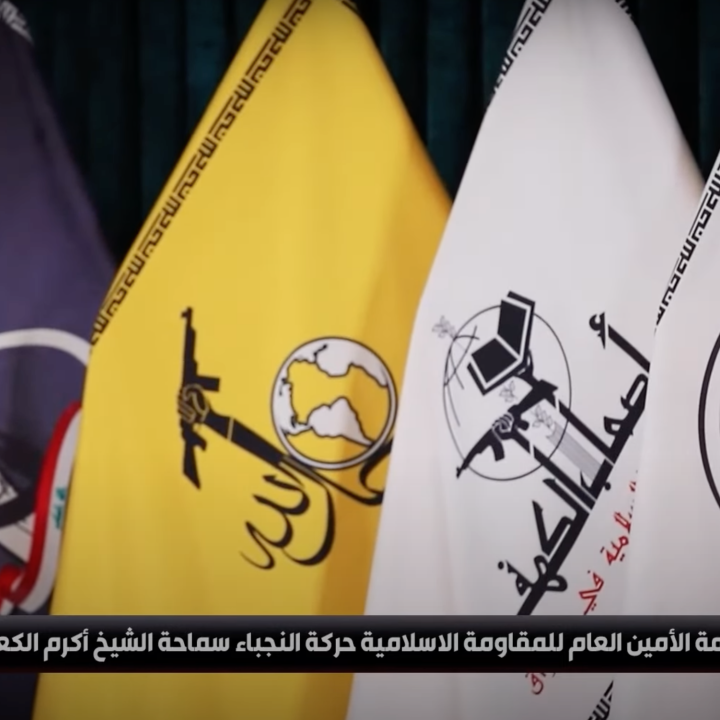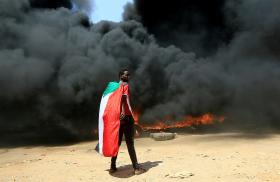
Akram Kaabi's Revealing Speech

Kaabi has long been Iran's chosen man in the self-styled Iraqi "resistance," and his latest remarks seemed like an attempt to seize control of militia public messaging.
On December 9, 2021, Akram Kaabi, founder of the Iraqi muqawama (resistance) group Harakat Hezbollah al-Nujaba (HaN), gave a televised speech in which he stood against a backdrop of flags from several militia facade groups. As shown in Figure 1, these groups included the following (from left to right, excluding the flags of HaN and Iraq):
- Saraya Thawat al-Ashrin al-Thaniya. A facade brand that has undertaken convoy attacks; it has been dormant since July but may be reactivated.
- Rijal Allah. This group claimed an April 22 attack in which at least three rockets landed within the perimeter of Baghdad International Airport, one of the last rocket attacks to be claimed by a facade group (as most such attacks have gone unclaimed since this summer).
- Ashab al-Kahf (AK). One of the most prominent facade groups, and the most active as of this writing. For the most part, AK claims roadside bomb attacks on civilian trucks that it says are supplying U.S. forces. Yet it also claimed to fire five rockets at Yesud HaMaala, a location close to the Golan Heights, in May. That claim was posted on muqawama social media channels on May 14, then quickly retracted, then reissued by another group known for extensively posting AK’s material, underlining AK's ownership of the statement. Militia Spotlight has previously assessed that AK is strongly linked to the militia Asaib Ahl al-Haq (AAH), based on the fact that AK channels express affinity for the group and its leader, Qais al-Khazali.
- Al-Muqawama al-Duwaliya. A facade group that emerged in January and primarily focused on claiming roadside bomb attacks against truck convoys. Its social media accounts demonstrate close affinity with HaN.
- Liwa al-Thaireen. A minor facade group that emerged this summer. On July 23, it claimed a drone attack on a coalition base in Erbil governorate. This was one of the last drone attacks to be claimed by a facade group (like rocket attacks, drone strikes became increasingly unclaimed after July).
- Liwa Thar Muhandis. A minor facade group that first appeared on May 21, 2020, and claimed two attacks from earlier that year: a May 6 strike on U.S. forces at Baghdad airport using four Katyusha rockets, and an April 17 strike targeting American Chinook helicopters in Baghdad with two missiles. After a period of dormancy, the group reemerged on July 7, 2021, with a new online channel that posted the following threat: “It is the U.S. army that will pay the price for the martyrs.” This post came twenty minutes after twelve rockets were fired on al-Asad Air Base during a week of escalation against the coalition—one of the first militia acknowledgements that the attack had occurred. Then, fifty-six minutes after the strike, the group's channel released a statement claiming responsibility for the incident and alleging it had fired thirty rockets. This claim was reposted by various accounts and channels linked to AAH and HaN.
- Liwa al-Qasim. A dormant facade brand that may be activated.
- Al-Tashkil al-Warithun. A dormant facade brand that may be activated.
By openly appearing alongside the flags of several facade groups, HaN and Kaabi have broken the norm of using such groups to obfuscate militias' direct responsibility for attacks. Although rocket and drone attacks have largely ceased to be claimed at all (instead being celebrated—but not attributed—by muqawama media), convoy attacks continue to be claimed by Ashab al-Kahf. The speech also suggests several other notable trends:
1. Kaabi and Iran are trying to recentralize control. Although Kaabi did not claim to speak for the muqawama coordination committee (Tansiqiya), of which HaN is a member, he nonetheless gave a clear indication that he was leading or speaking in the name of the facade groups. At a time when Iran's best-known proxies (Kataib Hezbollah and AAH) have been misfiring at the ballot box and with stunts such as the November 7 assassination attempt against Prime Minister Mustafa al-Kadhimi, it is no surprise that their emblems were not shown alongside Kaabi. The emblem of the Kataib Hezbollah-linked facade Qasem al-Jabbarin was not shown either, perhaps suggesting that the brand has entered a period of latency (Militia Spotlight has noted the cessation of the group's convoy claims since August). Meanwhile, the reliable Iranian partner Kataib Sayyid al-Shuhada has been moved to the forefront in Iranian-supported media like Sabereen News over the past few weeks.
2. Kaabi's unique role makes him comfortable associating HaN with facades. Kaabi has held special status in the muqawama since January 2020, when he moved to Iran after the killing of Qasem Soleimani and Abu Mahdi al-Muhandis and was given favorable treatment over all other militia leaders. His latest speech is the first time a fasail (armed group) leader has openly associated with facade groups, underlining his special role and relative immunity—unlike most other muqawama leaders, he is not physically in Iraq and has no apparent ambition to play an overt role in the country's parliament or security forces.
3. The muqawama are seemingly preparing to resume hostilities against the U.S. presence in Iraq. Kaabi's speech included numerous threats against the United States. In one salient passage, he declared, "Political means and talking about negotiations and political dialogue have proven to be a failure...The only language that Americans understand is the weapon of the muqawama and the barrel of the gun." He also stated, "Today, we are ready, as we were after 2003, to resist the American occupation from underground...We have pledged to the muqawama's fighters that we will avenge the blood of the two martyrs [Muhandis and Soleimani], along with the rest of the martyrs."
It is relatively rare for Kaabi to make public statements like this one, so he has in effect staked his credibility and leadership role on continued kinetic resistance. The speech may indicate growing Iranian support for muqawama kinetic activity in Iraq in 2022, or it may simply be the boilerplate commitment to resistance expected of anyone trying to seize leadership of the muqawama. Notably, Kaabi did not emphasize a deadline of any kind, mirroring recent statements by another Iranian trustee, Abu Ala al-Walai, about allowing the new year to pass peacefully. Both Kaabi and Walai may be softening the previous line announced on November 19, when the Tansiqiya stated, "We will be ready to dislodge the occupation as soon as the moment comes, and the deadline ends after twelve o’clock in the evening of 12/31/2021." Since that statement, muqawama media channels have been counting down to the end of the ceasefire on December 31.






